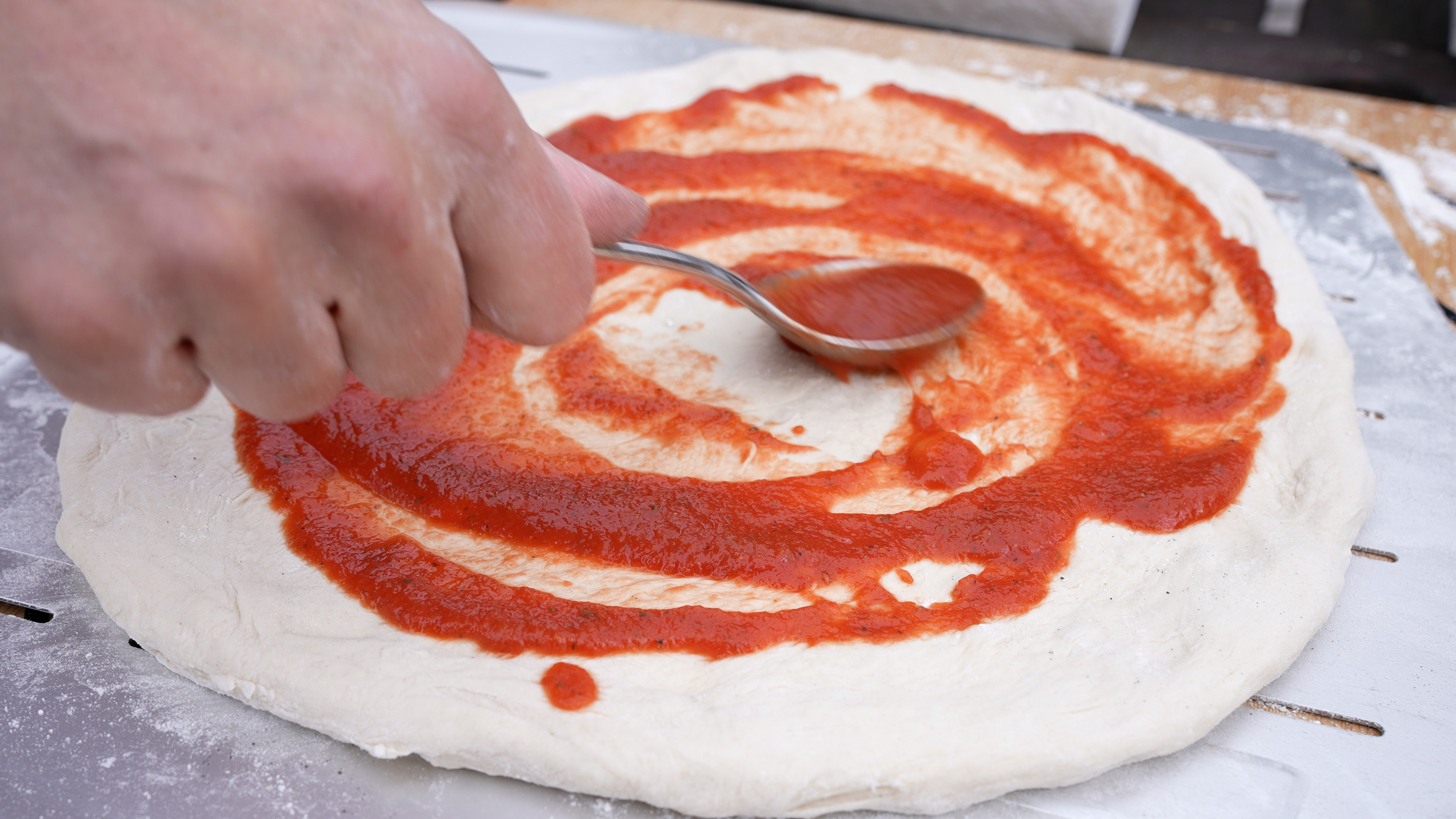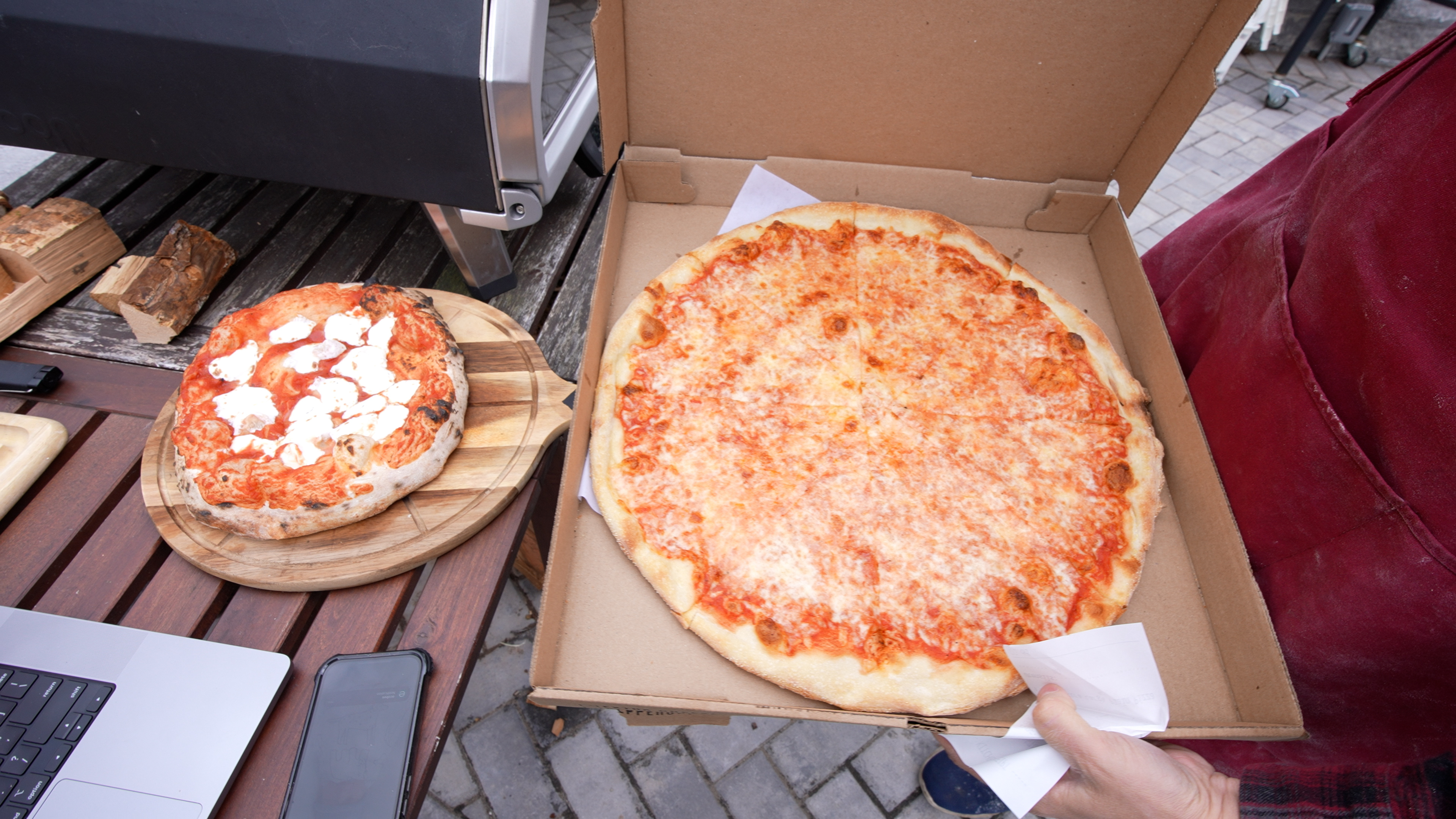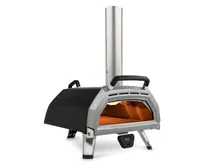Making pizza at home vs. delivery: I put it to the test
Can I make a pizza in less time than it takes to get one delivered?

I've tested a bunch of the best pizza ovens over the years, and one of the questions I always get from friends and family is "isn't it just easier to order a pizza?"
Well, yes, but it gave me an idea for a challenge: Could I make a pizza in less time than it takes to order one and have it delivered to my house? Is making your own pizza any more cost-effective (in the long run) than getting takeout? And, most importantly, which tastes better?
That's just what I set to find out one afternoon.
The gear
First, let's lay out what I'd be using,
Pizza oven: For this challenge, I decided to really test myself by using the Ooni Karu 16, and fire it up using wood, rather than propane. You have to pay more attention to the fire to ensure it doesn't go out, but it also lends a better taste to the pizza.
At $799, the Karu 16 is one of the most expensive in Ooni's lineup, but it lets you make the largest pies (until the Koda 2 Max arrives), and gives you the most options for fuel. However, you can get pizza ovens for less than half the price of the Karu 16, which definitely lowers your startup costs. If you're not sure which you prefer, check out our guide on which Ooni pizza oven is best for you.
Ooni Karu 16: was $799 now $720 @ Amazon
The Karu 16 is Ooni's top-end outdoor pizza oven, and can make pizzas up to 16 inches in diameter. As of this writing, it's 10% off.
It has a temperature readout in the front, and a glass door that helps keep the heat in. It can run on wood, wood pellets, charcoal, and propane, but for the latter, you'll need to purchase a propane adapter for $109.
Pizza peel: This is the big paddle thingy you see them use at pizzerias to slide the pies in and out of the oven. Trust me, you'll need one of these. Fortunately, they're relatively cheap: You can get one for around $30 on Amazon.
Get instant access to breaking news, the hottest reviews, great deals and helpful tips.
Fuel: As mentioned, I used wood to fire the Karu 16. You can buy a box of pizza oven oak for about $30 on Amazon, but if you have one of the best fire pits, you can just as easily use any dried wood — just cut it down to size to fit your pizza oven.
The ingredients

You can easily go the lazy route and just buy pre-made pizza dough from the grocery store or even a pizzeria, but making your own dough is deceptively easy, especially if you have one of the best stand mixers. It will take you maybe 10 minutes of active time, and you only need four ingredients: flour, yeast, salt, and water.
- Flour: I recommend using a flour with high protein, like King Arthur Bread flour ($6.99, Amazon). A five-pound bag will be more than enough for 7 large pizzas.
- Yeast: A 3-pack of Fleischmann's Dry Active Yeast will set you back about $3, and you'll have plenty left over.
- Tomatoes: If you're making a traditional pie, you'll want some tomato sauce. I like to use Mutti-brand passata ($4.99, Amazon) — pureed tomatoes that have been strained — and just add a dash of oregano, salt, and pepper. I don't bother cooking it beforehand —the oven will take care of that.
- Mozzarella: Fresh mozzarella is the best. I can pick up a 1-pound ball for around $10, and that's usually enough for three pizzas.
So, if we're using the whole bag of flour, I'm spending about $35 total on ingredients for seven pizzas. That works out to around $5 per pizza.
Of course, that doesn't include options for other kinds of pies. Margheritas are great, but sometimes you want something else. For this test, I also made a pepperoni pizza, and a white pizza with ricotta and nduja, a spicy, spreadable sausage.
By comparison, the pizza I ordered through GrubHub — A plain 18-inch New York-style pizza — cost $19.50, but when you add in delivery fees and tip, it ended up costing $29.81.

For this race, I made my own pizza dough ahead of time (it's cheating slightly, but I'm not including it in the time). I used a dough recipe from Marc Vetri's Mastering Pizza ($17.59, Amazon). This recipe makes 6 dough balls, each about 250 grams. I wanted to make larger pizzas, so I made just three pizzas from this recipe.
Starter:
- 354 grams bread flour
- 354 grams water at 45º F
- 0.8 grams (1/8 tsp) active dry yeast
For the dough:
- 241 grams water at 55º F
- 1.3 grams active dry yeast
- 638 grams bread flour
- 20 grams fine sea salt
- Combine the starter ingredients using a mixer or spatula, just long enough for everything to be incorporated. Cover tightly and let rest at room temperature (70º F) for 24 hours.
- Combine the dough water with the yeast and whisk together until frothy.
- Add water/yeast mixture to the starter, and then add flour and salt. Mix together using a mixer for about 7 minutes on low, and then 4 minutes on medium-low. Feel free to split into two batches if you have a smaller mixer and don't want to risk burning the motor out. When finished, the dough should be fairly smooth.
- Cover tightly and let ferment in the refrigerator until it almost doubles in size, at least 2 hours or up to 24 hours for more flavor. You can also let it ferment at room temperature if you don't have as much time.
- Divide up the dough into balls and roll them to that their surface is smooth; rather than dusting your hands with flour, coat your hands lightly with water to prevent the dough from sticking.
- Place each ball in an airtight container and let proof for 12-24 hours.
- On a floured surface, stretch out the dough to make your pizza.
After you stretch out the dough, don't overload the pizza with too much sauce or toppings; usually, all you'll need is a couple tablespoons of tomato sauce for a 12-inch pie.
The race is on!

At 3:00 p.m., I placed an order on GrubHub for a large plain pizza from a local store. It estimated that my pie would be delivered in about 30 minutes.
At the same time, I lit the fire in the Ooni Karu 16 to get things heated up. Then, it was simply a matter of waiting until the Ooni was at temperature. Would it heat up in time, or would my delivery get there first?
Once the Ooni was lit, I had to add a new chunk of wood every 5 minutes or so to keep the fire burning, and make sure the oven hits a temperature of around 800 degrees F.
3:10 p.m.: The Ooni's internal temperature is around 400 degrees.
3:17 p.m.: The Ooni's temperature hits 633 degrees.
3:21 p.m.: The Ooni's internal temperature his 733 degrees.
3:30 pm: The Ooni hits 800 degrees. I start making the pizza. First, I stretch out the dough on a wooden cutting board. Then, I transfer the dough to the pizza peel, and add sauce and mozzarella.

3:36 pm: I slide the pizza into the oven. About 30 seconds later, I rotate the pizza in the oven, and let it cook for another half-minute.
3:37 pm: The pizza comes out of the oven, and is ready to eat! (Well, it's still pretty hot).
3:38 pm: The pizza delivery arrives at my door.

And the winner is...

Me, of course! I just beat the delivery guy by about five minutes. If I was making the same kind of pizza as I had delivered, there would have been an even greater gap, as you don't have to get the oven as hot for a New York-style pie as you do for a Neapolitan-style pizza.
Ultimately, I spent $35 on ingredients, but was able to make three pizzas, and still had leftover ricotta, flour, yeast, and pepperoni. That's only $5 more than a single pizza from the local store. When you add in the cost of the oven and the pizza peel, that's $829. Let's say another $30 for fuel, too.
Rounding the figures, we have $859 for the startup costs and $5 per pizza. If we use $30 as the cost of a delivery pizza, then I would have to make roughly 34 pizzas before I broke even.
So, it'll take a while, but making your own pizzas at home could save you both time and, uh, dough. I'll admit that I'm not going to break out the pizza oven when it's raining or a major snowstorm is blowing through town, but any other time, I'll be outside slinging 'za.

Michael A. Prospero is the U.S. Editor-in-Chief for Tom’s Guide. He oversees all evergreen content and oversees the Homes, Smart Home, and Fitness/Wearables categories for the site. In his spare time, he also tests out the latest drones, electric scooters, and smart home gadgets, such as video doorbells. Before his tenure at Tom's Guide, he was the Reviews Editor for Laptop Magazine, a reporter at Fast Company, the Times of Trenton, and, many eons back, an intern at George magazine. He received his undergraduate degree from Boston College, where he worked on the campus newspaper The Heights, and then attended the Columbia University school of Journalism. When he’s not testing out the latest running watch, electric scooter, or skiing or training for a marathon, he’s probably using the latest sous vide machine, smoker, or pizza oven, to the delight — or chagrin — of his family.

